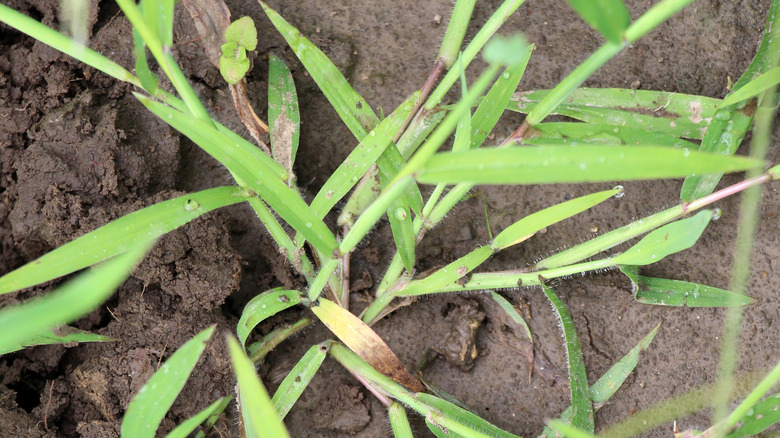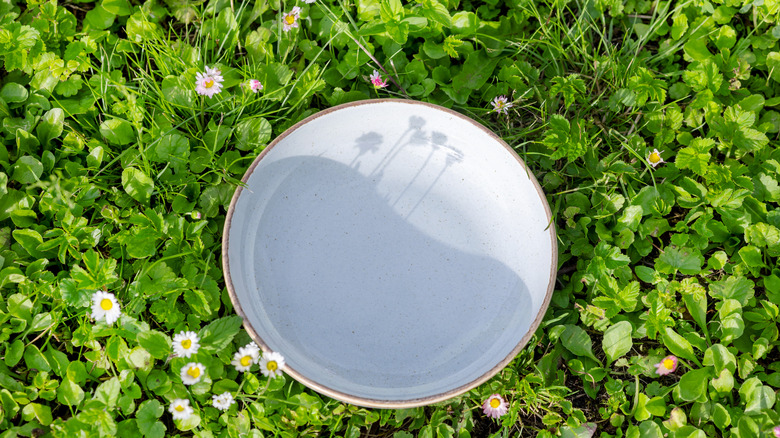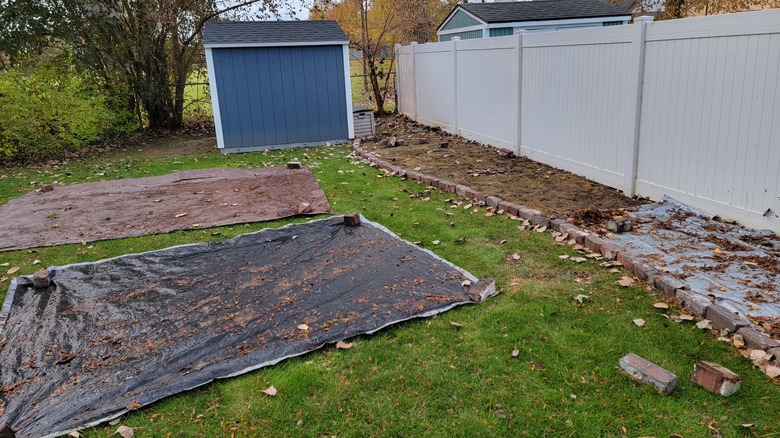An Unusual Solution To Annoying Crabgrass Is Hiding In Your Kitchen Cabinet
Crabgrass, the bane of most homeowner's existence, is a weedy grass that can quickly overtake lawns. Originating in Europe and Asia, this crabby grass was introduced in the U.S. as a forage crop in the mid-19th century. Since then, it has escaped cultivation and turned into an invasive weed that can easily take over natural areas, lawns, and gardens. Because of the pervasive nature of this pesky weed, people have gotten creative with managing it. However, this solution may take the cake for the most unusual — it involves using a plate from your kitchen cabinet to suffocate the plant and prevent it from getting sun, effectively killing the crabgrass in your yard.
This method of smothering can be pretty effective, and there's an official name for it: solarization. However, using a kitchen plate isn't the most traditional way of doing it. It's important to note, though, that this smothering method is only effective if your crabgrass infestation isn't severe, and only a few plants have popped up in select areas of your yard. If you're dealing with minor crabgrass infestation, this solution can stop the proliferation of the plant and save your yard from being completely invaded. But if the infestation has taken over more of your property, more intensive measures must be taken — and a kitchen plate won't be big enough to get the job done.
How to use a plate to choke out pesky crabgrass
The reason crabgrass is so invasive is largely because of its aggressive growth habit. It colonizes an area so easily because of its ability to put out "tillers," which are shoots that extend from the parent plant and root at each node. Additionally, when crabgrass goes to seed, it produces thousands and thousands of seeds that can lay dormant in the seedbed for a long time. Its growth habit gives it an advantage over other native crops and turf grasses, allowing it to choke out surrounding plants. Understanding its growth habits and lifecycle is essential for figuring out how to best manage crabgrass.
This plate solution works wonderfully when you just begin to notice a few crabgrass plants cropping up around your yard. Simply take your plate and place it facedown on top of the crabgrass. Leave it there for a few weeks or until the plant dies. This works by way of robbing the crabgrass of sun, thus killing it and its root system. If you don't want to use one of your kitchen plates, a tile, brick, or another small but heavy object can work. However, just make sure that whatever you use covers the entirety of the plant, as crabgrass can easily root from small exposed pieces of the plant.
How to apply this to a larger infestation & other management techniques
The best way to naturally kill crabgrass is through solarization, using a large tarp, weed cloth, or a clear plastic tarp to smother an area entirely and kill all vegetation and its root systems below. Also, if you leave the covering for long enough, it kills the seeds in the seedbed. If your lawn is severely infested with crabgrass, to the point that it's choked out most of your turf grass, resetting your lawn and starting over is the best approach. The cheapest way to do this will be to solarize your own lawn — all you need is a tarp or something to cover it with. You can then secure it with bricks or stakes, or anything heavy you have lying around.
Whether you use a small plate or a large tarp, either way, the job is getting done. When it comes to weed prevention, a good offense is the best defense. If possible, when you first see crabgrass popping up in your lawn, begin either hand-pulling it or burning it with a weed burner. Chemical options should not be used as they pose a serious threat to our health and the environment. Thankfully, organic cultural methods are just as effective as chemical methods and have the added benefit of not poisoning our waterways and bodies.


